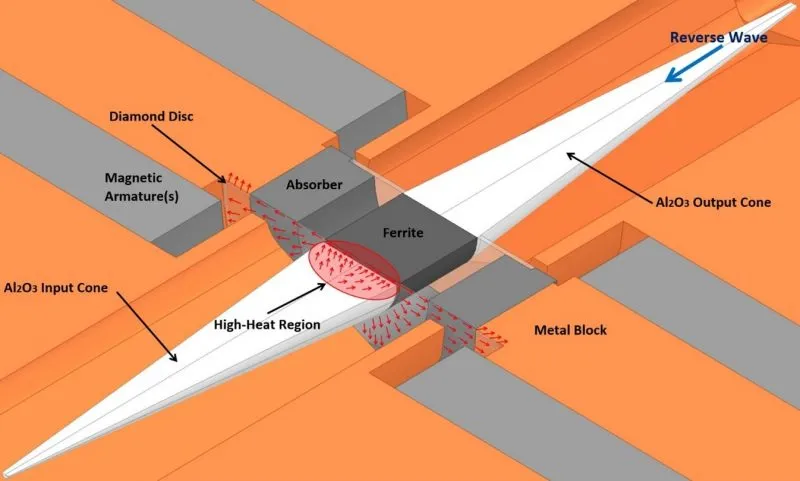Micro Harmonics isolators employ a modern design yielding significantly lower insertion loss than competing commercial products. They also work over much broader bandwidths in excess of standard waveguide bands. But there is another important difference that sets them apart from the competition. Our isolators employ a diamond support disc that channels heat from the resistive layer in the cone to the metal waveguide block and thus they can handle greater reverse power levels. To our knowledge no other commercial isolators offer this advantage.
At the heart of a Faraday rotation isolator is a pair of alumina cones and a cylindrical ferrite core. The cones are used to couple EM fields from the waveguides to the ferrite. The cones are bisected by a resistive layer along their central axis. In most commercial Faraday rotation isolators, the ferrite and cones are suspended by a pair of washer shaped supports as shown in the sketch below. The cone/ferrite assembly is inserted through the inner holes in the supports and then attached with a non-conductive epoxy. The support material is typically BOPET, polyimide, Styrene, a resin or some other material with a low dielectric constant and low loss at millimeter wave frequencies (see Table at the bottom of this article). Materials with these characteristics are generally in the class of thermal insulators and thus the cones and ferrite are thermally isolated from the metal block.
Power entering the output port of the isolator is absorbed in the resistive layer bisecting the input alumina cone. The absorbed power is converted to heat energy. Very little of this heat energy can be channeled away by thermal conduction through the supports, rather it must be dissipated through a radiative process or by means of convection through the surrounding air. The resistive layers are thus subject to high heat levels and even damage if too much reverse power is incident on the device. Historically this was not an issue as there was very little power available at these frequencies. But as higher power sources are becoming available there is a renewed interest in the power ratings of these devices.
At Micro Harmonics we have replaced the input support washer with a uniform optical-grade CVD diamond disc. Diamond is the ultimate thermal conductor approaching 2200 W/mK, more than five times higher than copper. The diamond disc is sandwiched between the base of the input cone and the ferrite. The diamond disc is in intimate contact over the entire area of the cone base. This is the optimal location for the diamond disc since it is the region subject to the highest heat levels.
The graphic below and to the left shows a split view of the isolator. The diamond disc is epoxied to the metal waveguide block over its entire periphery and thus provides an excellent conduit to channel heat away from the resistive layer. The red arrows indicate the path of heat flow. Even at low reverse power levels, our isolators should consistently run cooler with reduced thermal stress on the epoxy joints. The graphic below and to the right shows two isolator core assemblies (two alumina cones attached to a CVD diamond support disc and ferrite cylinder). The larger core assembly is used in our WR-15 isolator and the smaller assembly is used in our WR-3.4 isolator. The resistive layers bisecting the cones in the larger assembly are visible.
The table below shows material properties for some common thermal insulators and thermal conductors.
| Material | Description or Trade Name |
Thermal Conductivity W/(m•K) |
Dielectric Constant |
|---|---|---|---|
| Vacuum | 0 | 1 | |
| Polystyrene | 0.146 | 2.53 | |
| BOPET | Mylar®, Duralar® | 0.155 | 3.3 |
| Polyimide | Kapton®, Upilex-S® | 0.2 | 3.5 |
| PTFE | Teflon® | 0.25 | 2.1 |
| Resin | Stycast 1266® | 0.73 | 3 |
| Borsilicate Glass | Pyrex® | 1.1 | 4.6 |
| Stainless Steel | 15 | ||
| Alumina | 35 | 9.8 | |
| Platinum | 70 | ||
| Silicon | 150 | 11.9 | |
| Aluminum | 237 | ||
| Copper | 400 | ||
| Diamond | High-grade CVD | >2000 | 5.7 |
| Diamond | Crystalline | 2200 | 5.7 |
| Material properties vary by manufacturer, frequency, temperature, etc. | |||




